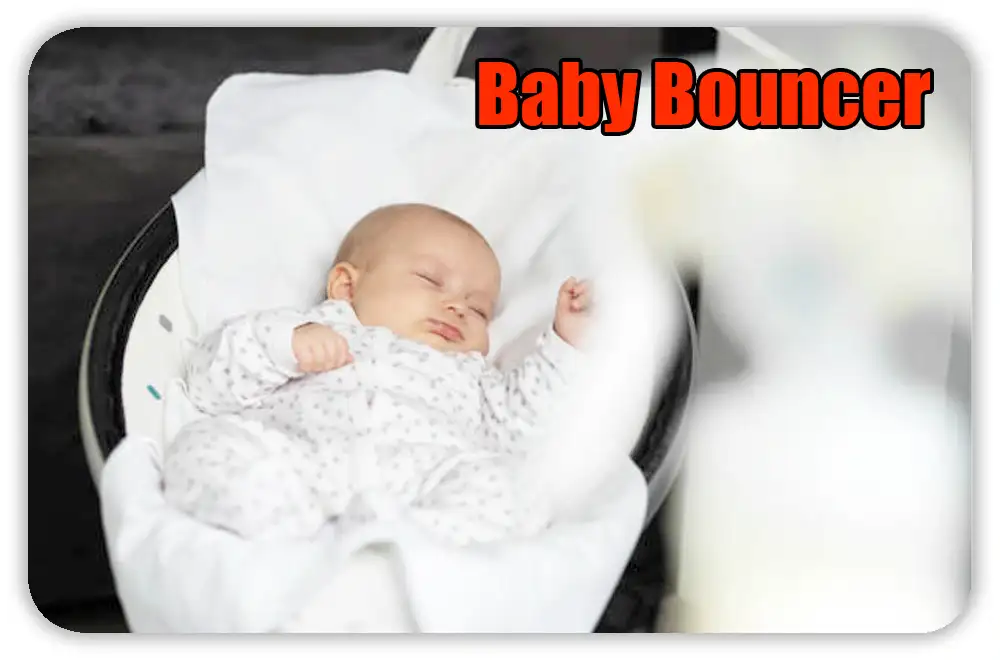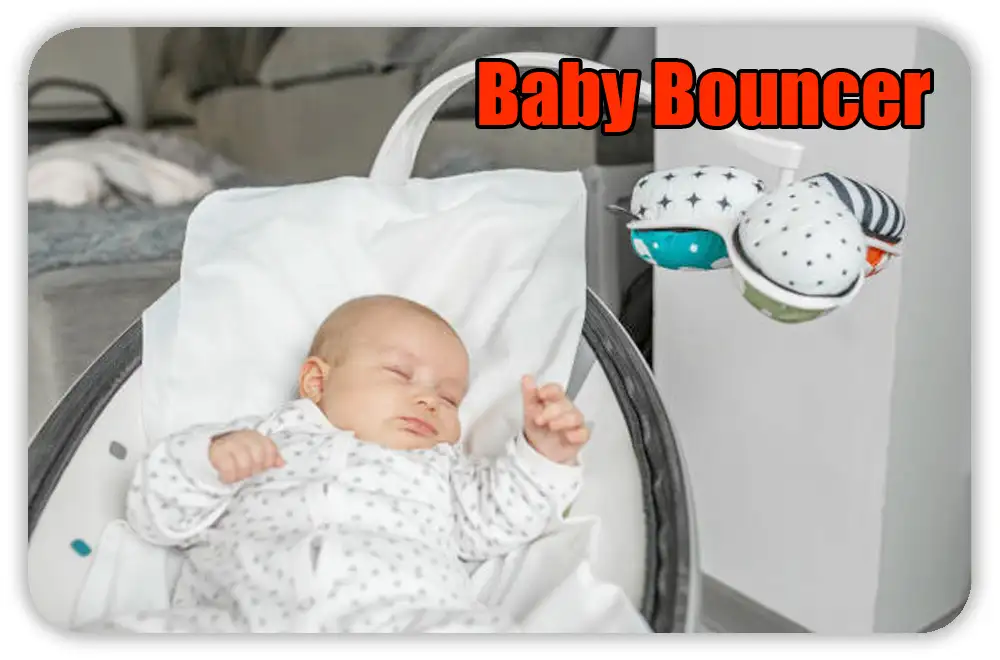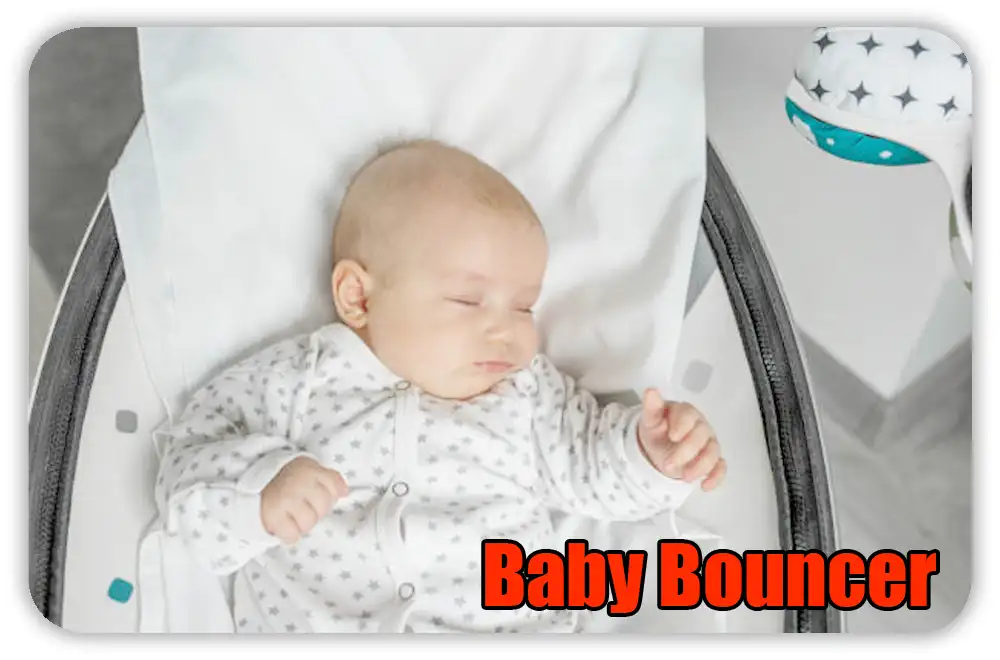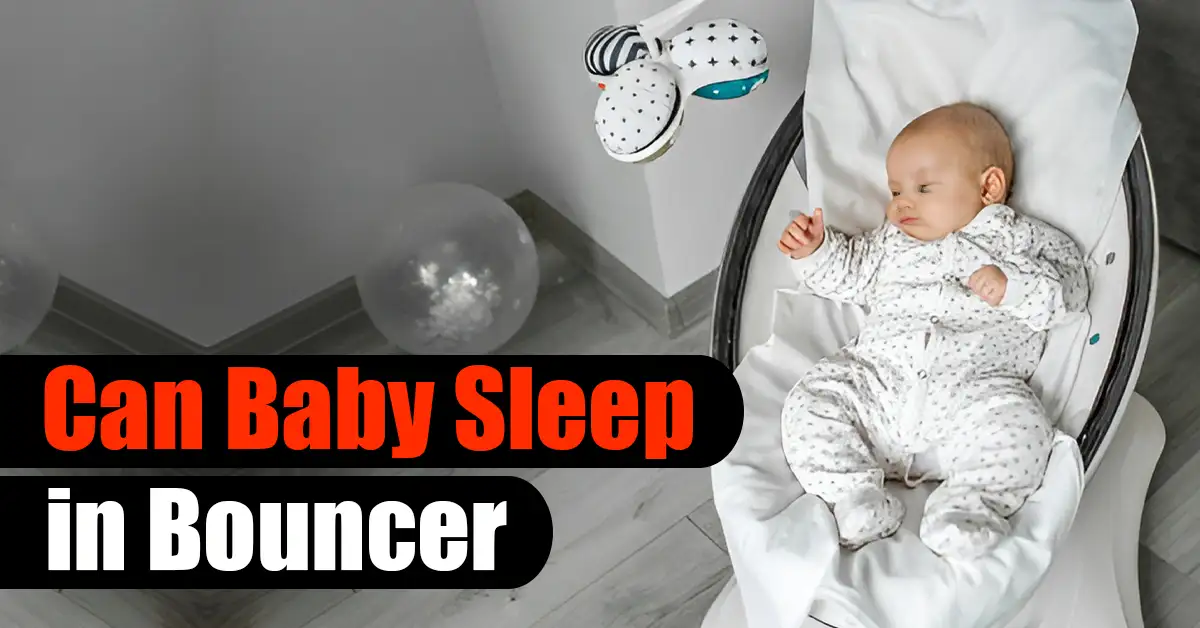I’ve been there. Baby finally falls asleep in the bouncer, and you ask yourself, “Is this safe?” The short answer: no, it’s not. Babies should not sleep in a bouncer.
I used to think a short nap was fine. But I learned the risks can be real. As a mom and a parenting writer, I’ve done the research. I want to share what I wish I had known sooner — and what safe choices worked better for us. Let’s break it down in simple words.
Table of Contents
Can a Baby Sleep in a Bouncer?
No — it’s not safe for a baby to sleep in a bouncer. I used to wonder the same thing when my baby would drift off during a late-afternoon bounce. It felt harmless, especially when I was tired and the house was finally still. But experts agree — bouncers are not made for sleep.
The American Academy of Pediatrics (AAP) warns against sleep in any seat that leans back, like a bouncer. Here’s why: when a baby sleeps upright, their head can flop forward. That can block their airway — a danger called positional asphyxia.
Bouncers also have soft padding and deep angles. These can let babies slump, roll, or get stuck in the straps.
Here’s a common myth: if a baby falls asleep in a bouncer, it must be safe. I used to think short naps were okay if I stayed close. But I later learned that even a fast nap can be risky — especially if I looked away or nodded off too.
So while the rocking might feel like a win during a tough stretch, the safest sleep spot is always a flat, firm surface like a crib or bassinet — not a bouncer.
Why Babies Fall Asleep in Bouncers So Easily
It’s no shock that babies doze off in bouncers — mine did it all the time. The soft bounce feels soothing. The motion, the sound, the snug seat — it’s like a warm hug. It worked like magic on fussy days.

Here’s why babies relax so fast in bouncers:
- Gentle motion: The bounce feels like how we rock them in our arms. Babies love motion — it’s how they lived in the womb.
- Upright angle: This can feel nice after a feeding, especially for babies with reflux. But even if it helps, it’s not safe for sleep.
- Cozy feel: Bouncers are often soft and snug. That warm spot can make babies drift off fast.
And let’s be real — for tired parents, it feels like a break. I remember thinking, “Finally, a minute to breathe!” when my baby snoozed in the bouncer. It’s so tempting to let them stay “just a bit longer.” But even short naps like this carry risks, which brings us to…
Health Risks of Letting Baby Sleep in a Bouncer
Even if your baby looks calm in the bouncer, sleeping there can be risky. I didn’t know this at first. I thought staying close was enough. But here’s what I found out:
- Blocked airways: When babies sleep upright, their heads can fall forward. That can block their airway. This is called positional asphyxia.
- Weak neck muscles: Babies can’t hold their heads up yet. If their head slumps, it can stop air from flowing.
- Higher SIDS risk: The AAP says soft or sloped seats raise the risk of Sudden Infant Death Syndrome. That includes bouncers, car seats, and swings — even for short naps.
- Bad posture: Bouncers aren’t made for sleep. Straps can press the wrong way. Babies can slide, slump, or twist in unsafe ways.
Doctors agree: the safest sleep is on a flat, firm spot — like a crib or bassinet. One study in Pediatrics found that babies who slept in sitting devices had a higher risk of sleep-related death. This was most true when the baby was outside of travel or wasn’t being watched closely.
I know it’s hard. I’ve been there — eyes half-shut, bouncer rocking, just hoping for five more quiet minutes. But now, I always move her. Even if she wakes up. It’s not worth the risk.
Expert Recommendations on Infant Sleep Safety
So what do the experts say about safe sleep? The American Academy of Pediatrics (AAP) keeps it simple: follow the ABCs of safe sleep — Alone, on their Back, in a Crib.

Here’s what that means:
- Alone — No pillows, toys, or blankets. Just your baby.
- Back — Always place your baby on their back to sleep.
- Crib — Use a flat, firm surface like a crib, bassinet, or play yard.
Bouncers don’t follow these rules. Pediatricians say they’re not safe for sleep — not even for quick naps. The angle, soft pads, and straps all add risks.
That said, it’s okay for your baby to be in a bouncer while they’re awake — as long as you’re watching. But once their eyes start to close? It’s time to move them.
What To Do If Baby Falls Asleep in a Bouncer
So your baby dozes off mid-bounce — now what? Don’t stress. It happens. The goal is to move them safely and gently.
Here’s what I do:
- Pause the motion: Stop the bouncing so they’re calm and still.
- Unbuckle slowly: Support their head and neck as you undo the straps.
- Pick them up gently: Hold your baby close with their head on your chest.
- Lay them on their back: Always place them on their back in the crib or bassinet.
- Soothe if needed: Try a pacifier, white noise, or a soft pat. I sometimes hum — it calms both of us.
Yes, sometimes my baby wakes up during the move. It’s hard. But it’s worth it. Over time, she learned to fall back asleep in her crib.
Safe Alternatives to a Bouncer for Sleep
If bouncers are off the list, what’s safe? Don’t worry — there are better, safer options.

Here’s what to use:
- Cribs and bassinets: These are the best choice. Make sure they meet current safety rules — most sold in the U.S. do.
- Play yards: Great for naps or travel. Many are approved for sleep and have firm, flat pads.
- Newborn loungers (for awake time only): These feel cozy but aren’t safe for sleep. Use them when baby is fully awake and you’re right there.
And if your baby has a hard time falling asleep?
Try these gentle sleep aids:
- White noise: Blocks other sounds and helps baby relax.
- Swaddles: Makes newborns feel snug (stop once baby can roll).
- Pacifiers: Can calm baby and lower the risk of SIDS.
I used a bassinet by my bed during those first weeks. It made night feeds easier and helped me rest easier too. It wasn’t always smooth — but it was safe. And that matters more than a few quiet minutes.
Read More: Is Momcozy Carrier Hip Healthy and Worth It?
Are There Any Bouncers That Are Safe for Sleep?
I’ve googled this at 2 a.m. more than once: “Are some bouncers safe for sleep?” It’s confusing. Many products look cozy and claim things like “naptime ready” or “soft sleeper.” But here’s the truth I’ve learned:
No bouncer is safe for sleep — not by medical standards.
Let’s clear this up:
There’s a big difference between a bouncer and a sleeper.
- Bouncers are made for awake playtime. They lean back and have soft padding — not safe for sleep.
- Sleepers, when approved for overnight use, follow strict rules. They’re flat, firm, and keep baby from slumping.
Some brands use words like “napper” or “rest mode.” It sounds safe, right? But marketing isn’t medicine. The AAP and doctors still say no — even if the label says it’s okay.
Watch out for these red flags:
- Deep reclining seats
- Soft headrests or thick cushions
- Loose straps or none at all
- No flat back support
If it doesn’t follow the “flat, firm, and on the back” rule — it’s not a safe sleep spot.
Mom-to-Mom Tips: How I Handle Naps Without a Bouncer
Let’s be real — when baby finally drifts off in the bouncer, it’s tempting to let them stay. I’ve been there. But over time, I built a nap routine that works (most days) — no bouncer needed.
Here’s what’s helped me:
- Create a nap-friendly space: I keep it simple: blackout curtains, sound machine, and a safe bassinet. No toys. No noise. Just calm.
- Watch for sleepy signs: When I see her rubbing her eyes or zoning out, I move fast. Catching sleep cues early makes naps smoother.
- Follow a rhythm, not a clock: I don’t follow strict times. I follow her. Some naps come after 90 minutes. Other days, sooner or later. I stay flexible.
- Use a short nap routine: Ours is quick: diaper change, soft hug, dim lights. Same steps every time. It sets the tone.
And the big one:
- Be okay with imperfect naps: Some are short. Some need a second try. Some days fall apart. That’s okay. You’re still doing great.
I used to feel bad when naps didn’t go “by the book.” Now, I focus on what’s safe and what works for us. That’s what matters most.
Final Thoughts: Bouncers Are Great — But Not for Sleep
Bouncers help. They soothe, distract, and give you a break. I still use mine — just not for naps or sleep.
Here’s the truth I wish I knew sooner:
Just because a baby falls asleep in something doesn’t mean it’s safe.
For sleep, stick to the basics:
Alone. On their back. In a crib. Simple. Safe. Backed by every expert I trust.
I know this stage is hard. You’re tired. You’re doing your best with what you’ve got. But even in the tough moments, choosing safety matters.
You’re doing an amazing job — and your baby’s safety always comes first.
FAQs: Can Baby Sleep in Bouncer?
Can babies sleep in a bouncer safely?
No. It’s not safe for babies to sleep in a bouncer. The angle and soft padding can block their airway and raise the risk of SIDS.
Why is sleeping in a bouncer dangerous?
Bouncers let babies slump forward. This can block their airway. It’s called positional asphyxia and can happen fast.
What should I do if my baby falls asleep in the bouncer?
Move your baby to a flat, firm sleep space like a crib or bassinet. Always place them on their back to sleep.
Are there any bouncers made for safe sleep?
No. Even if a bouncer says “nap approved,” it’s not safe for sleep. Experts say babies should never nap or sleep in them.
Can newborns nap in a bouncer if I’m watching?
Watching helps, but it’s not enough. Bouncers are for awake time only. For naps, always use a crib or bassinet.

